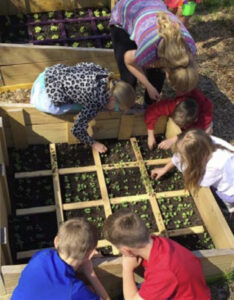When school teacher Jodie Visker wrote to us about her Edible Schoolyard Project program, we knew we had to share her inspiring story with you. Read in Jodie’s own words how she has introduced children and their families to the practice of growing and harvesting their own food. Amazing work, Jodie! We’re so proud of how you are using Square Foot Gardening to teach lifelong healthy habits and how you and your students are contributing to the community!

Wisconsin teacher Jodie Visker
The Onalaska School Garden program began in 2011 when our school district received a Farm to School Grant. I was asked to design school gardens as a result of district officials’ awareness of another youth vegetable gardening project I had been doing. I’m a master gardener who has been growing vegetables for over 20 years as well as a former art teacher, so I was thrilled to take on the challenge!
I began by building six Square Foot Garden beds at each of our three elementary schools. I also use cold frames on top each of the beds to extend our season and allow our students to eat what they grow during the school year. We grow lettuce, radishes, and spinach in the very early spring, then replant with warm-season veggies before school is let out in the summer. Spring produce is used for a school-wide sampling and also used in the salad bar. Families volunteer to take turns watering and harvesting the summer garden to get an idea of what it would be like to have a backyard garden. They take home what they harvest. Cherry tomatoes continue growing when school starts again in the fall and are harvested for the schools’ salad bars.
The garden has now expanded to include 4-by-8-foot compost beds/pumpkin patches and a garden at our middle school, plus indoor gardens using Tower Gardens at all levels. I also coordinate another project with high school kids where we grow a large Square Foot-styled garden. We donate the produce to the local food pantry. This garden is really incredible and a true testament to how well Square Foot Gardening works!
I was first introduced to Square Foot Gardening about 20 years ago when I was an eager gardener in my first home. My initial garden was a bit of a failure. Then a family friend sent me some back issues of Organic Gardening. In one issue, I found an article by Mel Bartholomew that was an introduction to the Square Foot Gardening method. I located his first book in the library, followed the instructions, and my second garden was a happy jungle full of all the yummy veggies I had been dreaming of!

The Square Foot Method is easy enough for 8-year-olds to follow.
I’m a creative person who doesn’t always like to be confined by too much structure, so in a way I’m surprised this very specific method appealed to me, but I loved how complete and practical the information was! I didn’t want to waste any time or resources, or grow more than I needed. Plus, I was a complete beginner with no clear idea of how to grow vegetables well, despite reading book after book of general gardening information. In the beginning, I started out using the original method of SFG, but when I was faced with the task of starting vegetable gardens at three schools, I looked into the All New Edition. I was skeptical of growing in only 6 inches of soil, but working with a limited budget, I decided I couldn’t afford deeper beds, so I gave it a try. It has been a huge success! I’m so appreciative of the books and the building of the SFG Foundation that Mel Bartholomew has created. It has meant so much to me personally and in my work, which is a true labor of love! I have recommended this method to many adults as well; I’ve even taught several classes in the community.
I always recommend SFG to other aspiring school garden coordinators because it works with children, and works with large groups in general, and it is so low-maintenance. I can’t imagine a better method to use when working with several students at a time. Thanks to the use of the grid and the 4-by-4- foot beds, I can simply model an example of how to plant a square, then let students work independently on their own square without having to supervise each one. Amazing when you think about the fact that I mostly work with 8-year-olds and that we grow enough lettuce to feed a whole school for at least a week! The raised beds and lightweight Mel’s Mix™ soil outlined in the book reduce my need for tools as well—a real budget saver! Most days my equipment list simply includes several plastic hand trowels (about a dollar each), some kneeling pads from the dollar store, and a few free 5-gallon buckets.
Our school garden has impacted literally thousands of children, not only giving them a hands-on learning experience about how food grows, but also encouraging better nutrition through eating vegetables. I’m truly grateful for having learned the Square Foot Gardening method so early in my gardening journey and being able to use it to teach so many others about the joy of gardening!
